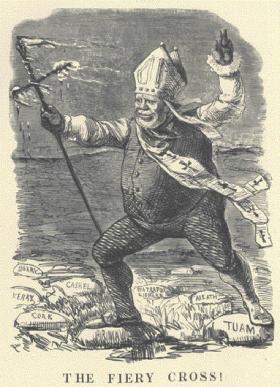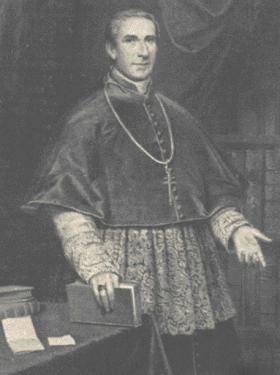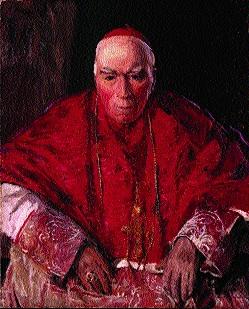The Catholic Church and Fenianism
Published in 18th-19th Century Social Perspectives, 18th–19th - Century History, Features, General, Irish Republican Brotherhood / Fenians, Issue 6 (Nov/Dec 2008), Volume 16
Mid-nineteenth-century cartoon of an all-conquering Archbishop Paul Cullen. (Multitext)
The struggle between the Catholic Church and the Fenians, as this evolved in the mid-nineteenth century, had its origins in the wider context of the church’s horror of revolution and revolutionary movements. The locus classicus for this antipathy was the experience of the French Revolution and its aftermath. Equally, the spectre of revolution haunted Europe from the 1830s and would culminate, so far as the church was concerned, in the sweeping away of the centuries-old Papal States in 1860 and the loss of Rome to the Italians in 1870. Thereafter Pius IX declared himself to be the ‘prisoner of the Vatican’, and forbade Catholics to have anything to do with the new Italian political entity.
Pius’s views on emerging democracy had already been given vituperative expression in his 1864 encyclical Quanta Cura, to which was appended the infamous Syllabus of Errors. In that document the pope had condemned anyone who advocated the separation of church and state or that the pontiff should reconcile himself with progress, liberalism or ‘modern civilisation’.
When the church was forced to confront revolutionary movements in Ireland, it took its lead in this, as in so much else, from Rome. Archbishop Paul Cullen, created a cardinal in 1867, led the church’s attack on Fenianism from the movement’s first public manifestation, under its front organisation the National Brotherhood of St Patrick, at the MacManus funeral in 1861. Cullen’s views were shared to varying degrees by a number of his colleagues in the Irish hierarchy, most notably by David Moriarty, bishop of Kerry. Moriarty was the quintessential representative of a long line of ‘Castle-bishops’. Much to Cullen’s consternation, however, Moriarty was a theological liberal. Nonetheless, like Cullen he feared that the political instability occasioned by Fenianism would also result in a destabilisation of religious sensibilities. Those who disregarded political authority as represented by the state would, in time, come to disregard religious authority as represented by the church and the bishops.
‘A flaw in creation’
Moriarty’s somewhat eccentric views were given full expression in his infamous sermon of February 1867. Even those who shared Moriarty’s basic outlook were surprised by the vehemence of his utterance. Cullen, for example, thought the sermon was ‘a foolish exaggeration’. His political opponents accused him of inventing a new religion, ‘the British connection’. The Irishman, rising to the theological challenge, detected in the bishop’s sermon what it termed ‘a flaw in creation’, since according to Moriarty God had failed to make eternity long enough or hell hot enough for the Fenian leaders.
Surprisingly, perhaps, Moriarty was convinced that many of the younger priests were, at least passively, supporters of Fenianism. Most members of the hierarchy rejected this suggestion, as indeed did influential members of the political ruling classes. Lord Naas, chief secretary for Ireland, told parliament, in the light of the Fenian rising of March 1867, of his conviction that Catholic priests in general had used their influence to prevent the Irish people from taking part in Fenianism. The Times praised the ‘remarkable loyalty’ of priests and bishops in ‘holding themselves aloof from the [Fenian] conspiracy’.
By that time the church had already acted both in Britain and in North America to discourage Catholics from joining the Fenian Brotherhood, by refusing its members access to the sacraments. As early as 1865 the American bishops had obtained a ruling from Rome that urged priests not to absolve Fenians and to use the confessional to induce individuals to leave what was, under the terms of Catholic canon law, a secret oath-bound organisation condemned by papal constitutions and pronouncements.

The ‘Lion of the West’, Archbishop John MacHale of Tuam, was a Fenian sympathiser for at least part of the 1860s. (Multitext)
Archbishop John MacHale of Tuam
At the same time it is also clear that a small minority of priests, and one or two bishops, did give some encouragement to Fenianism. Fr Patrick Lavelle was a staunch supporter of both the National Brotherhood of St Patrick and the Fenian organisation. His ecclesiastical superior, the redoubtable ‘Lion of the West’, Dr John MacHale, archbishop of Tuam, was also a sympathiser for at least part of the 1860s. MacHale was imprudent enough to send several autographed portraits of himself to the Chicago Fenian convention in 1863. The monies raised from the auction of these paintings were applied for Fenian purposes. This of itself may have represented no more than personal vanity on the archbishop’s part, but rumours began to spread that MacHale had taken the Fenian oath to demonstrate that it was not in itself sinful. The archbishop took no decisive action to dispel these rumours.
For the ecclesiastical opponents of Fenianism there was a clear presumption that the British state in Ireland was the legitimate government and that conspiracy against such a government was contrary to God’s law. At the same time, many priests and bishops were convinced that the government would use the pretext of political disorder to impose restrictions on the Catholic Church. Such thinking on the part of Cullen and others may simply have been the product of anti-Protestant paranoia. On the other hand, governments had, since the 1830s, enacted legislation that was deeply irritating to many bishops. Such legislation was of two types. In the first place, parliamentary bills such as the Charitable Bequests Act of 1848 and the Ecclesiastical Titles Act of 1850 imposed both theoretical and practical restrictions on the Catholic Church in Ireland. Secondly, government attempts to improve the social and educational standing of Irish Catholics with regard to primary and university education gave further scope for complaint among Irish ecclesiastics about the treatment of Catholic interests by the British state.
The IRB, so far as Cullen was concerned, represented a direct threat to his aims and ambitions for Catholic culture in Ireland. Since his arrival in the country from Rome in 1850, Cullen was determined to ensure that Catholics would take their rightful place in Irish society. He was anxious to consolidate the social and economic gains of the arriviste Catholic middle classes. Indeed, it was especially among this group that Cullen had his greatest initial success in propagating the ‘devotional revolution’, which helped make Ireland a conformist and ultramontane bedrock of the English-speaking Catholic world.
Despite what is sometimes said, Cullen was not in fact an unreconstructed Irish nationalist. If all he desired for Ireland could be obtained within the context of the Union, then Cullen was prepared to be a unionist. Even the foundation of the Catholic University in Dublin was justified on the basis, among others, that it would provide well-educated Catholics who would take influential positions in the far-flung regions of the British Empire. Imperial expansion had its equivalent in the developing spiritual empire of Roman Catholicism, in which Ireland was playing a significant part. Furthermore, at any given time in the nineteenth century between a third and 40 per cent of soldiers in the British army were Irish Catholics. Their deployment helped to ensure the building of Catholic churches everywhere in the empire from Brisbane to Barbados.
Battle for control of public discourse
In some respects this was the heart of the problem for churchmen in dealing with Fenianism. Catholic Ireland as an instrument for the spread of global Catholicism was best placed to play that role in the context of the British Empire. The church, however, at times felt its position in Ireland to be undervalued and even undermined by the Protestant state. Clearly by the 1860s this was beginning to change, but the emergence of Fenianism at this point threatened the development of the church’s social and political influence. It did so not so much because of its insistence on the separation of church and state and its dislike of clerical involvement in politics, but rather because it obscured the church’s agenda. Fenianism would never be satisfied with the reformism demanded by the church. The IRB wanted a restructuring of political society in Ireland, a restructuring that was incompatible with the church’s ambitions. The Fenians rejected the attempts by the church to pose as the only true defender and promoter of the interests of the Irish people. To that extend the battle between the church and the Fenians was one concerning the control of public discourse, and ultimately of political and social destiny.
Fenianism, then, represented a direct challenge to both the British Empire and the spiritual empire that the Catholic Church was constructing on the coat-tails of British colonial expansion. For his part, Cullen made it clear that it was the first duty of Catholics to support the government, unless the government attacked the church. By contrast, the Fenians accused the church of evaluating the problems facing Ireland from the viewpoint of the state. In addition, they correctly concluded that the social ambitions of the middle classes inevitably coloured the political perceptions of churchmen.

Cardinal Logue, who said the government could not be faulted for punishing (i.e. executing) the 1916 leaders, provided it did so ‘within the laws of humanity’. (Estate of Sir John Lavery)
Couldn’t stop mock funerals for Manchester Martyrs
The clerical response to the threat of Fenianism was also, however, conditioned by public opinion. Instances of harsh treatment or perceived injustices meted out to Fenian prisoners opened up division in the clerical body. The public hangings of Alan, Larkin and O’Brien in Manchester in November 1867 brought such tensions to the fore. Nevertheless, Cardinal Cullen and his supporters took a firm line against religious services for ‘dead terrorists’. They could not, however, prevent large demonstrations in towns and cities, often in the form of mock funeral processions, in response to the hangings. The Irish bishops, with the exception of MacHale, welcomed a government ban on such displays imposed on 15 December 1867.
Public sympathy for Fenianism was also manifest in the amnesty movement for the release of Fenian prisoners. In this the Irish priesthood was more ambiguous than were the Irish bishops. The Catholic dean of Limerick, Richard O’Brien, addressed a memorandum to his fellow clergy asking them to sign a petition for the release of the prisoners. By late December 1869 it had attracted some 1,400 signatures out of a total priesthood of some 3,000. As a result of the petition and the relentless political activity of Fr Patrick Lavelle, the Irish bishops, in Rome for the First Vatican Council, decided to ask for a papal condemnation of Fenianism. Almost simultaneously the government also asked for a papal intervention. The condemnation was duly issued in January 1870 and made public the following month. The American bishops were, on the whole, displeased since they had not been consulted in the matter.
Despite the condemnation and the political developments as represented by the Home Rule movement, the Fenians did not go away. By 1875 the Synod of Maynooth found it necessary to reiterate Pius IX’s strictures. In 1883 the Vatican’s ‘Propaganda Press’ issued ‘a retrospective’ of Cardinal Cullen’s teaching on Fenianism with the intention of disabusing ‘those ignorant persons’ who thought that they could be both good Catholics and good Fenians.
Archbishop Croke described himself as a ‘hillside man’
The confused state of Irish politics in the 1880s saw constitutionalist and physical force devotees vying with one another for public sympathy. More paradoxically, the hierarchy’s desire to exercise continued political influence in the Parnellite era enabled displays of overt nationalism and support for radical causes that would have been unthinkable even a decade earlier. Thus in 1886 Archbishop Thomas Croke of Cashel contributed five pounds towards the cost of a monument erected in the grounds of Limerick Cathedral to the ‘Manchester Martyrs’ of 1867. Croke would sail close to the wind by describing himself as a ‘hillside man’, a clear reference to Fenianism. His association with the GAA, membership of which often went hand in hand with Fenian support, also confirmed him as the MacHale of his age, writ large.
The ecclesiastical drift in a radical direction in the post-Cullen world could not for long be allowed to obtain. As a result of the mission from the Holy See to Ireland led by Archbishop Ignazio Persico, Pope Leo XIII, in April 1888, condemned the Land League’s Plan of Campaign and the practice of boycotting. Persico blamed the Fenians for the spread of radical ideas and for political tensions between priests and people. Such tensions forced the clergy to entertain radical ideas in order to regain the sympathy of the masses.
In the face of the collapse of Parnellism, the church was once again able to wrest influence in Irish politics from the radicals and by 1900, with the re-emergence of a united parliamentary party, could uphold its authority in the political sphere with the election of Bishop (later Cardinal) Patrick O’Donnell of Raphoe as the treasurer of the party. The rise of Sinn Féin from 1908 did little to disrupt the church’s tranquil relations with constitutional nationalism. But the IRB-inspired Rising of Easter 1916 was ultimately to provide a more formidable challenge for bishops and priests.
1916 Easter Rising
Individual priests and bishops condemned the Rising in the days and weeks after Easter Monday 1916. Even in the face of the early execution of some of the leaders Cardinal Logue could say that no one could fault the government for punishing the rebels, provided that it did so ‘within the laws of humanity’. The bishops decided not to officially support a church-door collection for those who had suffered in the rebellion, in case this was interpreted as support for the insurrection.
In June the hierarchy set up a subcommittee of bishops to draw up a statement setting out the church’s hostility to revolution. By October 1916 they concluded that such a statement would, at that stage, be inappropriate and serve no useful purpose. The situation was simply too delicate for any dramatic anti-revolutionary pronouncement. Not for the first, nor indeed the last, time would political expediency condition what were supposedly moral pronouncements by the Catholic Church in Ireland in dealing with the Fenians and their successors.
Despite what it liked to portray as its unchanging moral position, it is clear that the church underwent considerable change in its thinking on the Fenians. Its basic instinct was to uphold the established political order. When it became clear that this was no longer possible, it changed its position to enable it to still command the loyalty of the Irish people and to exercise influence in the political sphere. For its part, the Irish hierarchy was subject to pressure from the British government, the authorities in Rome and popular opinion at home. It could at times afford to resist the latter and would certainly have preferred not to concede ground to revolutionary influence as represented by Fenianism. Nevertheless, when the crunch came it was, with remarkable adroitness, able to accept the structures of the new Irish state, which were born out of revolutionary violence in the twentieth century. Such violence it did its best to retard in the nineteenth century by its repeated condemnation of Fenianism.
Oliver P. Rafferty SJ teaches church history at Heythrop College, London.
Further reading:
J. Aan de Weil, The Catholic Church in Ireland 1914–1918: war and politics (Dublin, 2003).
A. Macauley, The Holy See, British policy and the Plan of Campaign 1885–93 (Dublin, 2002).
E.R. Norman, The Catholic Church and Ireland in the age of rebellion (London, 1965).
O.P. Rafferty, The church, the state and the Fenian threat 1861–75 (London, 1999).
















